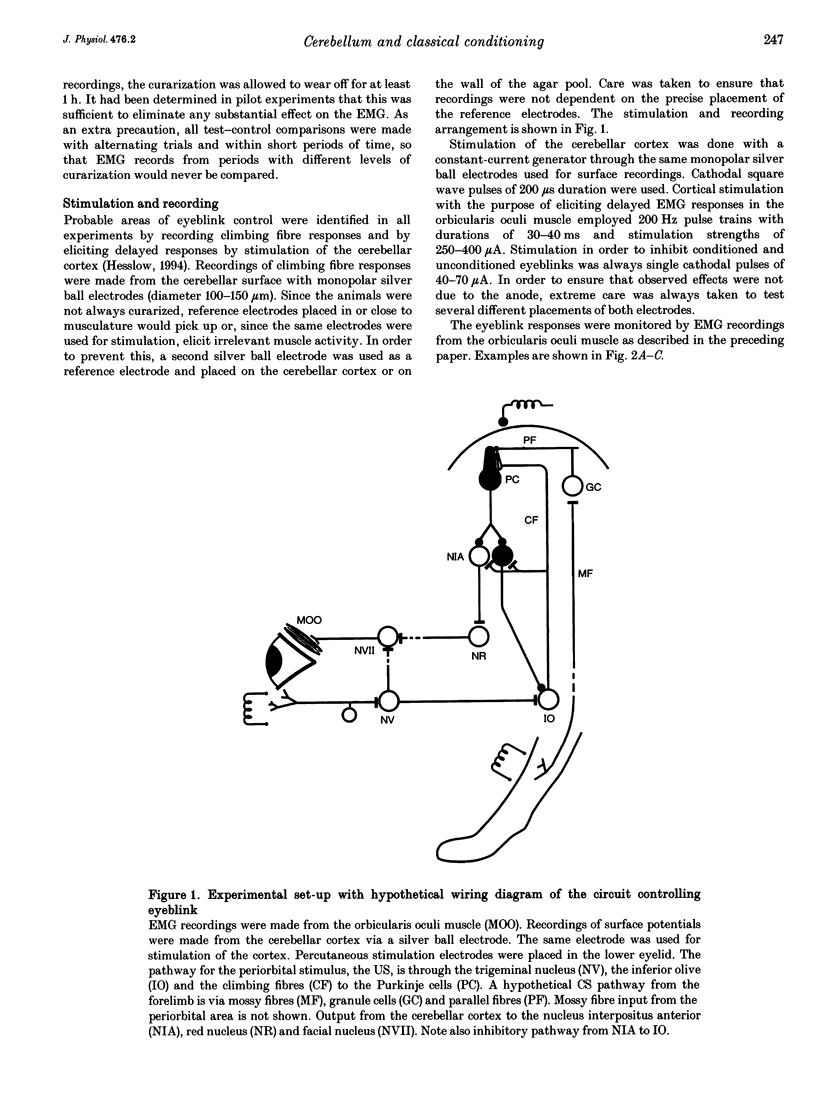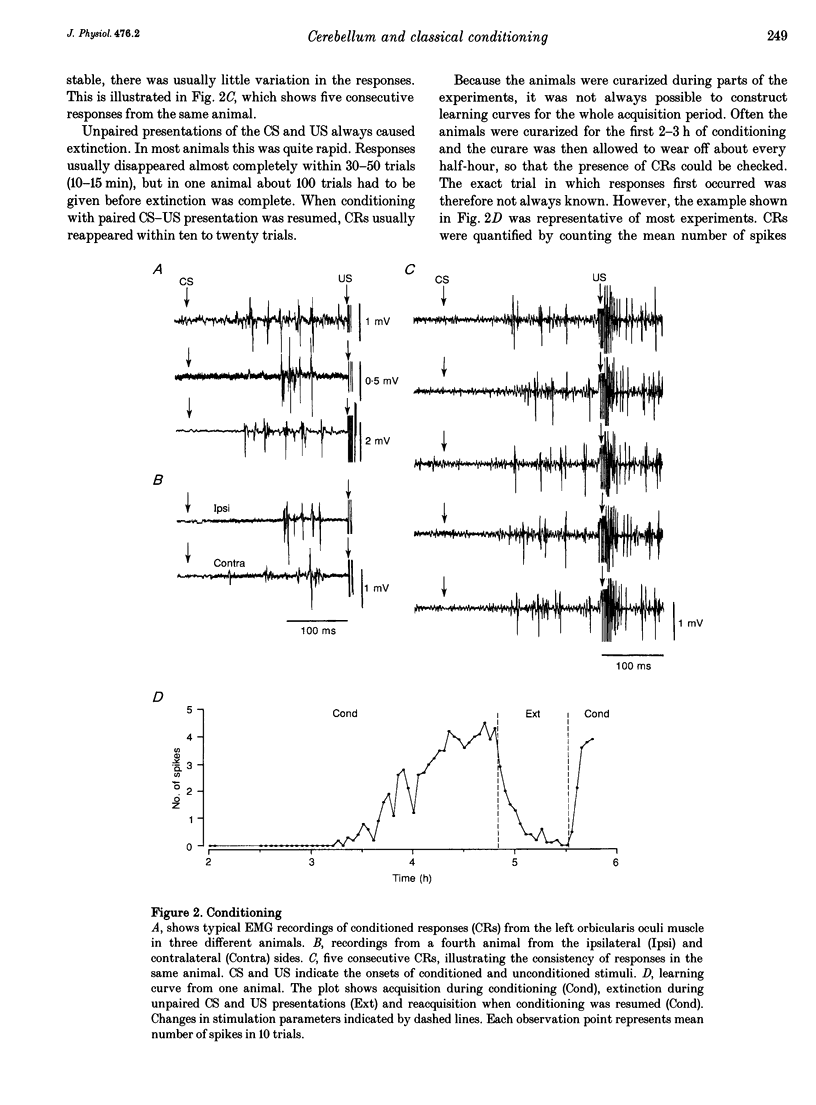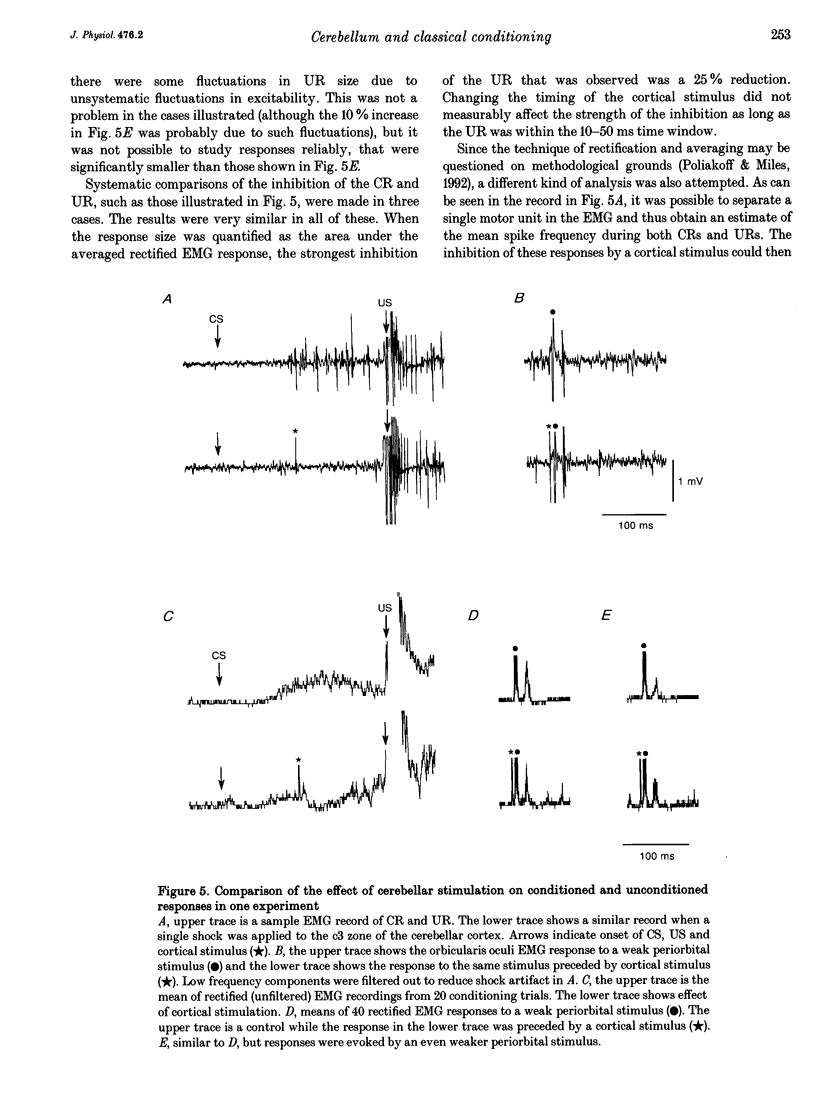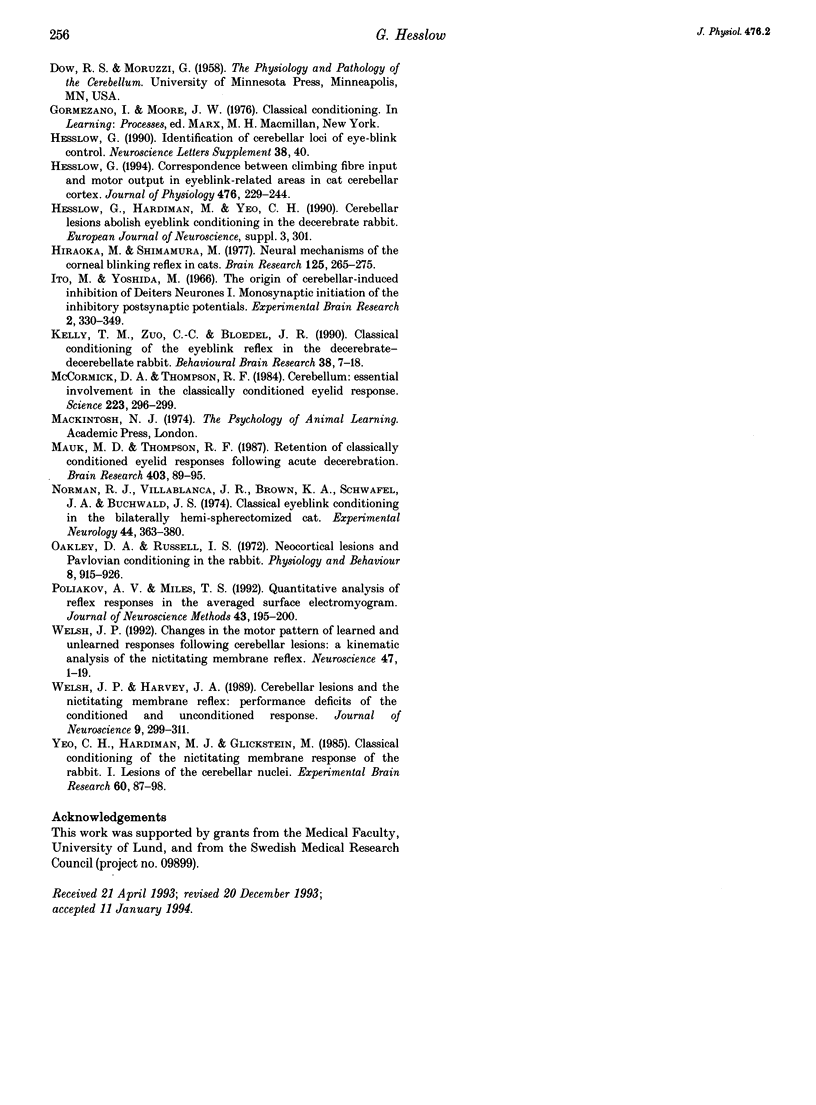Abstract
The purpose of the present study was to test the hypothesis that neurones in the anterior interpositus nucleus, under the control of Purkinje cells in the c1 and c3 zones of the cerebellar cortex, exert some control over classically conditioned responses. In particular, the experiments were designed to determine whether the cerebellar control of conditioned and unconditioned responses is different. The experiments were performed on cats decerebrated rostral to the red nucleus under halothane anaesthesia. The cats were conditioned using either a 1000 Hz tone or trains of stimuli through the skin of the proximal forelimb as the conditioned stimulus, and periorbital electrical stimulation as the unconditioned stimulus. A large proportion of the animals acquired conditioned responses at normal rates. It could be shown that these were true conditioned responses and did not result from sensitization or pseudoconditioning. For instance, unpaired presentations of conditioned and unconditioned stimuli caused rapid extinction. Cerebellar areas controlling eyeblink were identified by recording climbing fibre responses in the cerebellar cortex and recording EMG activity in the eyelid evoked by stimulation of the cerebellar cortex. When single shocks of 40-70 microA were applied to these areas during the emission of conditioned eyeblink responses, the latter were strongly inhibited. The inhibition had a latency of about 10 ms and a duration of 25-75 ms. It was shown that this inhibition of the conditioned responses was topographically specific and could only be evoked from cortical sites identified as controlling eyeblink. Stimulation of the periphery of an eyeblink area caused little or no inhibition. The effect of cortical stimulation on unconditioned reflex responses in the orbicularis oculi muscle was also tested. Some inhibition of unconditioned responses was observed, but quantitative analysis showed that this inhibition was considerably weaker than the corresponding inhibition of conditioned responses. The magnitude of the inhibition was determined for unconditioned responses of different sizes including responses which were weaker than the conditioned responses. It is concluded that conditioned eyeblink responses are under strong cerebellar control from areas in the c1 and c3 zones receiving climbing fibre input from the periorbital area. This effect is not likely to be due to a reduction in the background facilitation of facial motoneurones. In contrast, the weak inhibition of the unconditioned response was probably due to this mechanism. The results, therefore, suggest that the conditioned responses are dependent on the cerebellum in a way that is not true of unconditioned responses.
Full text
PDF











Selected References
These references are in PubMed. This may not be the complete list of references from this article.
- Andersson G., Oscarsson O. Projections to lateral vestibular nucleus from cerebellar climbing fiber zones. Exp Brain Res. 1978 Aug 15;32(4):549–564. doi: 10.1007/BF00239552. [DOI] [PubMed] [Google Scholar]
- Armstrong D. M., Harvey R. J., Schild R. F. Cerebello-cerebellar responses mediated via climbing fibres. Exp Brain Res. 1973 Aug 31;18(1):19–39. doi: 10.1007/BF00236554. [DOI] [PubMed] [Google Scholar]
- Bloedel J. R. The cerebellum and memory storage. Science. 1987 Dec 18;238(4834):1728–1730. doi: 10.1126/science.3686013. [DOI] [PubMed] [Google Scholar]
- Hesslow G. Correspondence between climbing fibre input and motor output in eyeblink-related areas in cat cerebellar cortex. J Physiol. 1994 Apr 15;476(2):229–244. doi: 10.1113/jphysiol.1994.sp020126. [DOI] [PMC free article] [PubMed] [Google Scholar]
- Hiraoka M., Shimamura M. Neural mechanisms of the corneal blinking reflex in cats. Brain Res. 1977 Apr 15;125(2):265–275. doi: 10.1016/0006-8993(77)90620-5. [DOI] [PubMed] [Google Scholar]
- Ito M., Yoshida M. The origin of cerebral-induced inhibition of Deiters neurones. I. Monosynaptic initiation of the inhibitory postsynaptic potentials. Exp Brain Res. 1966;2(4):330–349. doi: 10.1007/BF00234779. [DOI] [PubMed] [Google Scholar]
- Kelly T. M., Zuo C. C., Bloedel J. R. Classical conditioning of the eyeblink reflex in the decerebrate-decerebellate rabbit. Behav Brain Res. 1990 Apr 16;38(1):7–18. doi: 10.1016/0166-4328(90)90019-b. [DOI] [PubMed] [Google Scholar]
- Mauk M. D., Thompson R. F. Retention of classically conditioned eyelid responses following acute decerebration. Brain Res. 1987 Feb 10;403(1):89–95. doi: 10.1016/0006-8993(87)90126-0. [DOI] [PubMed] [Google Scholar]
- McCormick D. A., Thompson R. F. Cerebellum: essential involvement in the classically conditioned eyelid response. Science. 1984 Jan 20;223(4633):296–299. doi: 10.1126/science.6701513. [DOI] [PubMed] [Google Scholar]
- Norman R. J., Villablanca J. R., Brown K. A., Schwafel J. A., Buchwald J. S. Classical eyeblink conditioning in the bilaterally hemispherectomized cat. Exp Neurol. 1974 Sep;44(3):363–380. doi: 10.1016/0014-4886(74)90202-7. [DOI] [PubMed] [Google Scholar]
- Oakley D. A., Russell I. S. Neocortical lesions and Pavlovian conditioning. Physiol Behav. 1972 May;8(5):915–926. doi: 10.1016/0031-9384(72)90305-8. [DOI] [PubMed] [Google Scholar]
- Poliakov A. V., Miles T. S. Quantitative analysis of reflex responses in the averaged surface electromyogram. J Neurosci Methods. 1992 Jul;43(2-3):195–200. doi: 10.1016/0165-0270(92)90029-d. [DOI] [PubMed] [Google Scholar]
- Welsh J. P. Changes in the motor pattern of learned and unlearned responses following cerebellar lesions: a kinematic analysis of the nictitating membrane reflex. Neuroscience. 1992;47(1):1–19. doi: 10.1016/0306-4522(92)90116-j. [DOI] [PubMed] [Google Scholar]
- Welsh J. P., Harvey J. A. Cerebellar lesions and the nictitating membrane reflex: performance deficits of the conditioned and unconditioned response. J Neurosci. 1989 Jan;9(1):299–311. doi: 10.1523/JNEUROSCI.09-01-00299.1989. [DOI] [PMC free article] [PubMed] [Google Scholar]
- Yeo C. H., Hardiman M. J., Glickstein M. Classical conditioning of the nictitating membrane response of the rabbit. I. Lesions of the cerebellar nuclei. Exp Brain Res. 1985;60(1):87–98. doi: 10.1007/BF00237022. [DOI] [PubMed] [Google Scholar]


